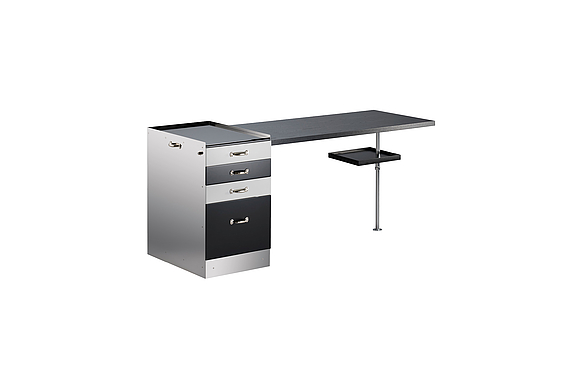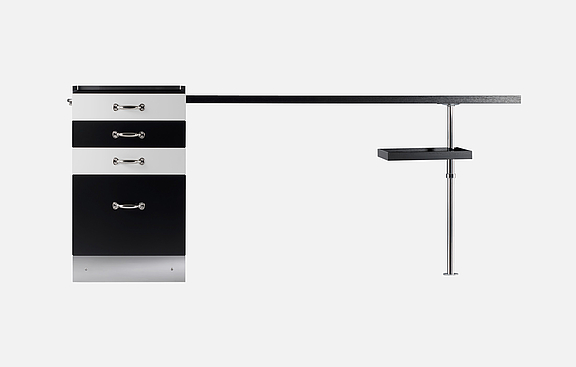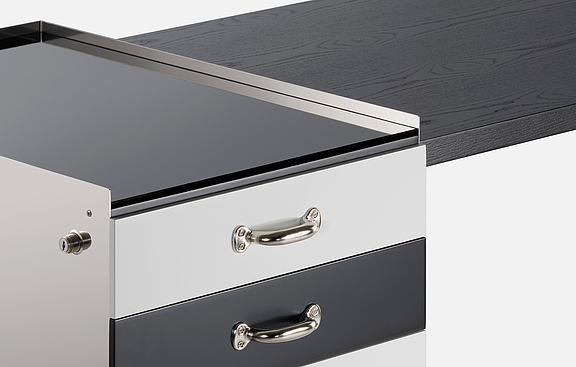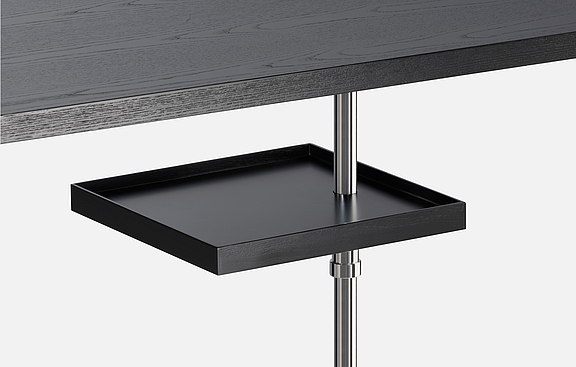
M45
Desk with commode
Bauhaus Original
Marcel Breuer
1932


M45
Stability and motion
Corpus
High-grade steel, 1 handle on side, glass top, 3 drawers and ext. for hanging files, with castors, 1 drawer with lock, dividing of colours on choice
Tabletop
Ash veneer, lacquered black, chromed column with adjustable and swivelling plate
Dimensions (cm)
Width: 220
Depth: 61
Height: 71
The desk from 1932 stands out for its deliberate asymmetry. On one side it features a heavy square chest of drawers, in bold black and white stripes. On the other there is a flash of steel, a column supporting a swivelling tabletop. The sculptural combination of standing leg and free leg, in an abstract interpretation: stability and motion. Marcel Breuer reconciles calm and dynamism quite matter-of-factly. Like the K40 coffee table, the combined chest of drawers (three drawers, plus a hanging file) and clear black ash tabletop stood in Erwin Piscator's Berlin apartment, furnished by Breuer in 1928. There it appeared for the first time with a single top and a single column.
The desk with its chest of drawers still looks fresh and contemporary after all these decades. Its zebra pattern still influenced designs that were reissued in the 1980s. At the same time, the design refers to a student project by Breuer, which he had created for the “Haus am Horn” in 1923. A dainty dressing table that is impressive both for its functional simplicity as well as for its delicate, movable elements. Breuer further refined the combination of elements of stability and motion. The stainless steel handles look striking against dark ash wood and the black lacquered drawers, creating visual highlights. On request, an M45-1 version of the desk is available featuring a smaller tabletop with a width of 160 centimetres.


Perfection of construction and detail. Of course, the first thing we associate with Bauhaus master Marcel Breuer is one material: tubular steel. And one principle: the cantilever chair, which sparked modern furniture design. “Humankind was freed from the tethers of rigid sitting to enjoy the freedom of the floating seat. The cantilever chair was a symbol of its time.” But this does not really do justice to Marcel Lajos (“Lajkó”) Breuer (1902-1981). What he really pursued was research into the essence of objects: what should, what can a modern piece of furniture do today, was the Bauhaus question.
In 1925, Breuer became head of the furniture workshop in Dessau as a “junior master”. The year before, he had already postulated his definition of contemporary furniture. Although he attached great importance to details, Breuer favoured the precision of thinking over formal aspects. “There is the perfection of construction and detail, along with and in contrast to simplicity and generosity in form and use,” he wrote in an essay outlining his philosophy.
His role in popularising tubular steel for furniture design may also be due to his being one of the first to realise how dynamic our lives had become, demanding equally light and flexible solutions. The cycling enthusiast also embraced the latest trends in architecture, industry and design for a new zeitgeist. “I have specifically chosen metal for these pieces of furniture to achieve the characteristics of modern spatial elements,” explained Breuer. “The heavy upholstery of a comfortable armchair has been replaced by tightly stretched fabric surfaces and a few lightweight springy cylindrical brackets.”
In addition, the construction was no longer hidden, but flashing chrome became a visible part of the design. Cantilever chairs were bolted, not welded, functions stacked and colour-coded. The result was a dematerialised floating appearance and a new spirit of space. The cantilever chair meant a liberation from the thousand-year-old model of rigid throne-like sitting. It was the implementation of the functional, kinetic and constructive counter-principle. This kinetic line, the dawn of the modern era, can still be traced to the young Bauhaus designers today.